Chart of the Day: Personal Income and Outlays
I have sifted through the most recent personal income data and wanted to show you a few charts that might indicate where we’re heading.
First, there is personal income. It’s fallen off a cliff since the recession began. Looking at the six-month average to smooth out blips, personal income growth peaked way back in June and July of 2006 at 7.8%. The rate of change in personal income is a leading indicator of the economy’s direction because, absent tax changes, less money usually means less spending.
If you notice in the chart, the steep peaks and valleys run in line with the business cycle. Right now, we are in the worst period in the 50 years of this particular data series by a large margin. The change in personal income began increasing from a low of -1.9% in July and August of 2009, where I expect the technical recession’s end date to be called.
I have previous data series going back to 1929 and you can see much steeper peaks and valleys in the Great Depression (and to a lesser extent in the mini Depression of 1949). I hope the chart below gives you a sense of the difference between today and the Great Depression.
The downturn has been attenuated somewhat by tax cuts. If you look at disposable personal income, the peak was again Jun-Aug 2006 at a 7.1% change year-on-year. This plummeted to a low of 0.5% in Jul-Aug 2009 – so, not as bad as personal income, but pretty horrific nonetheless as it is the worst performance since record keeping began – by a long shot.
How has that all translated into consumer spending? Again, we see some serious cliff diving in Personal Consumption Expenditures (PCE) – the worst performance since record keeping began – negative year-on-year numbers for the first time ever. The interesting bit is that the downturn in consumption was well before the downturn in income. That is not the usual pattern. The peak change was 6.7% in Aug-Nov 2005. That’s a year before the summer 2006 peak in income and points to house prices as a potential reason.
In contrast, during the last recession we saw a Apr-Jul 2000 peak in PCE and a Sep 2000 peak in income. Before that, the peak was Feb 89 for PCE and Jun 1989 for income. And going back to before the 1980-82 recession, you see a peak in Sep 1978-Jan 1979 in PCE versus a peak in Aug-Oct 1978 in income. I think the fact that consumption’s peak change was a year before the peak change in income is meaningful.
The last bit which I flashed yesterday is savings. Here are two charts. One is the long view from 1960 and the second is the short view from the last few years. I have used non-averaged month-to-month data for the second chart to show you the abrupt up-shift in personal savings.
You can see very distinctly that there was a massive spike in savings starting May 2008 as President Bush’s stimulus package came online. But, then savings cratered again, only to rise inexorably after the Indy Mac failure. More recently it has started down again.
Conclusions? Because we are looking at aggregate data, things move pretty slowly. So, when you see a pattern emerging in averaged rolling data over more than a few months, you can bet it will last. On that score, the savings rate has clearly shifted up. The low point was a 12-month average of 1.4% in April 2008. It has risen every month since.
But, the same is also true for personal income, after-tax income and consumption. All of these have been moving up for 4 to 5 months now. For me, the data confirm that a technical recovery is underway. But, they also point to asset prices as a contributor to the decline in spending growth starting in 2005. If house prices are still too high as I believe they are, eventually they will come under pressure. We should see this reflected in consumption – even before we see it in income. Look to PCE as a double-dip canary in the coalmine then.
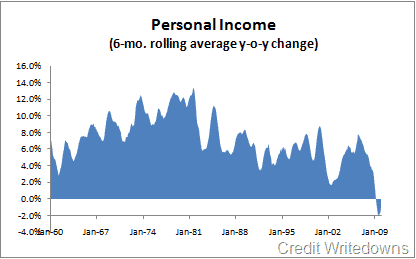
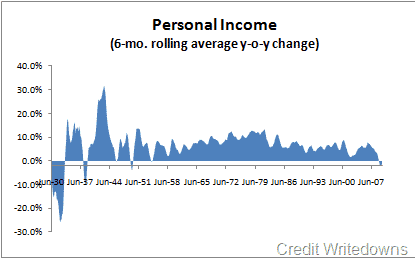
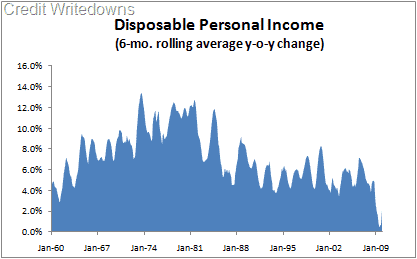
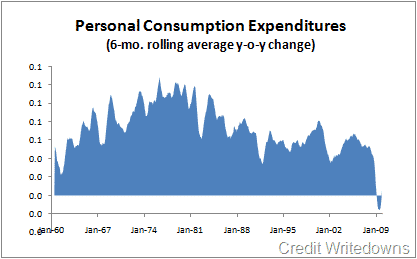
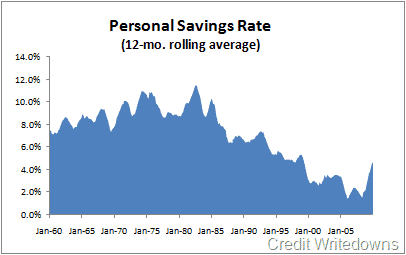
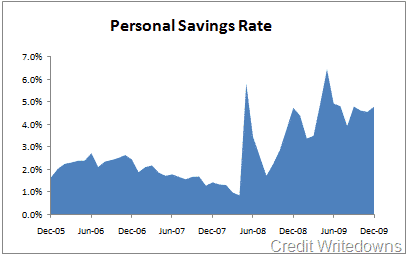
How much of the personal income is from transfer payments and how much is truly earned? Does this question matter if the conclusion is that government can hand out free money w/o any limit (and generally w/o any consequences) as Marshall has argued?
Separately, how much of PCE is imputed economic rent on past purchases and how much is real purchases of goods and services?
“How much of the personal income is from transfer payments and how much is truly earned?”
I’m not 100% sure since I’m from europe and don’t know the details of your system, but the second chart might answer your question.
https://econompicdata.blogspot.com/2010/02/were-all-socialist-now.html
Daniel, I will have to look to see what a graph of transfer payments looks like. That way we can look separate wages out of personal income. I had someone who saw this post at Seeking Alpha ask the same question.
When it comes to government spending, Marshall is right about there being no free lunch. Money from the government’s programs pays just like any other money. And there is no embedded inflation in a system with 17% underemployment and 70% cap. utilisation.
So we should not be asking whether the government’s money is as good as the private sector’s but rather whether the government’s spending is as good. That’s where the real debate lies. I believe I am more sceptical here.
Of course, in the absence of increased government spending, you get depression. That’s always something you should keep in the back of your mind.
In a message dated 2/3/2010 09:56:37 Mountain Standard Time,
writes:
So we should not be asking whether the government’s money is as good as
the private sector’s but rather whether the government’s spending is as
good. That’s where the real debate lies. I believe I am more sceptical here.
Perhaps, but if the private sector is not spending (as it the case today),
then who is left to do the spending?
In a message dated 2/3/2010 02:38:08 Mountain Standard Time,
writes:
How much of the personal income is from transfer payments and how much is
truly earned? Does this question matter if the conclusion is that
government can hand out free money w/o any limit (and generally w/o any
consequences) as Marshall has argued?
More “free lunch” rhetoric! The spending is not “handing it out”, but is
seeking to offset lost output. When that money is spent, it creates new
real assets. I’ve never argued that there are no consequences (again, a
total mischaracterisation of my position from people who don’t read it
carefully). If there is too much government spending, it can get inflationary. We
want government spending to be neither too hot, nor too cold. But with
17.5% under and unemployment and 70% capacity utilisation, it’s hard to make
the argument that government spending is going to create inflation. That’s
more likely to happen as we approach fuller employment and higher capacity
utilisation, which is exactly the objective here.